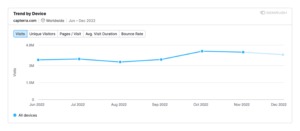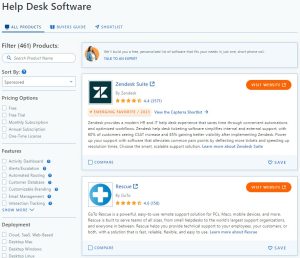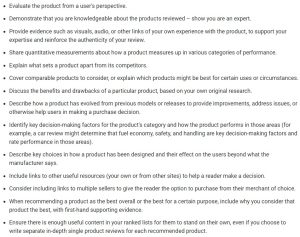Reviews are incredibly impactful – and essential – for business marketing and profitability. According to a recent study, over 99% of online shoppers refer to reviews when making purchase decisions, making them the top factor impacting consumer choices. (Source: Power Reviews)
However, reviews don’t just influence buying behavior – they can also boost your business’ online visibility. Reviews have become a significant component of both paid and organic search marketing strategies, with Google rolling out a series of updates that reward review content in search results.
If you want to stay ahead of the competition, it’s time to start prioritizing reviews in your marketing strategy. In this guide, we review Google’s product reviews system, its impact on digital marketing, and how you can make the most of this algorithm update.
What is the Product Reviews System?
The Google product reviews system is designed to reward review content that is most helpful and useful to searchers. Periodically, Google releases an update to the system, called a product reviews update. The latest February 2023 product review update is the sixth in a series of releases that date back to April 2021.
According to Google’s documentation, the product reviews system is aimed at providing searchers with reviews that include “in-depth research, rather than thin content that simply summarizes a bunch of products.” Rankings may improve after a product reviews update if Google deems the product review as having “content that provides insightful analysis and original research” written by “experts or enthusiasts who know the topic well.”
Any site that publishes review content may be impacted, including:
- Merchant sites with shopper guides
- Independent blogs
- News or other publishing sites
Currently, the product reviews system affects searches in the following languages globally: English, Spanish, German, French, Italian, Vietnamese, Indonesian, Russian, Dutch, Portuguese, and Polish. These updates do not consider user-generated content, like reviews on a product page.
How Does the Product Reviews System Work?
The product reviews system is based on Google’s machine learning algorithm, which uses hundreds of signals to identify “helpful” reviews. Many of these signals are focused on the quality of the review content. According to a blog post from Google software engineer Perry Liu, the system is designed to reward content that:
- Includes helpful in-depth details, like the benefits or drawbacks of a certain item, specifics on how a product performs, or how the product differs from previous versions.
- Comes from people who have actually used the products, and show what the product is like physically or how it’s used.
- Includes unique information beyond what the manufacturer provides — like visuals, audio, or links to other content detailing the reviewer’s experience.
- Covers comparable products, or explains what sets a product apart from its competitors.
The product reviews system machine learning algorithm may use structured data to understand if a site includes review content. However, structured data is optional and not the only indicator used to identify reviews online.
Content is evaluated by search engine crawlers primarily on a page-level basis. However, site-wide assessments may be made on domains that contain a high percentage of product review content. In other words, if your website does not have many reviews, you’ll only see pages that contain this type of content rewarded by these updates.
The product reviews system requires a periodic refresh from Google. In the past, updates have been anywhere from two to eight months apart. This means you might not see immediate improvements after improving or creating new content. Rather, sites need to make changes and wait for the next update to see rankings improve. Google’s John Muller also explained that the product reviews algorithm might be incorporated into the overall web search rankings at some point. In this case, we should expect to see quality reviews be rewarded on a more consistent basis.
How Can you Benefit from the Most Recent Product Reviews Update?
The most recent February 2023 update to product reviews system has shown a preference for review content across many high-volume, product-focused queries. Since its release, we’ve seen robust review content monopolizing the first-page search results. For one B2B software client, 70% of the SERP on their top sales-driving keyword is review content. This has created a higher level of competition on the SERP.
Even if your website does not focus on review content, you may still be able to take advantage of the next product review update to gain visibility on key terms for your business. There are two ways to benefit from review content as a business selling a product:
- Have your products featured on existing 3rd party review websites, such as Capterra or Software Advice
- Create your own review content to rank on Google organically
1. Using Capterra to Benefit from the Product Reviews Updates
Capterra is a comprehensive database and search engine that customers can use to browse software options and read user reviews. As one of the largest and most trusted websites dedicated to software reviews, it’s no surprise that Capterra has been affected by product reviews updates. You’ll find Capterra, or other Gartner websites like Software Advice or GetApp, ranking on page one of Google for pretty much any “best” software query.
The chart below shows an increase in estimated traffic to the Capterra website right after the release of the September 2022 product reviews update.
 Source: Semrush
Source: Semrush
Software companies can take advantage of Capterra’s rankings by running paid ads on their review pages. The Capterra Ads program allows you to bid on the top positions for their software category pages.
 Source: Capterra
Source: Capterra
Advertisers set their bid to receive clicks to their website, with the highest bidders shown in the highest positions on Capterra’s page. Organic listings for products within the category are still present, but they appear further down on the category page. Capterra’s highly specific categories and large user base make it an excellent option for lead generation, especially as the product reviews system continues to reward their website with top rankings on Google.
2. Creating Review Content on Your Own Product
If you want to grow organic traffic to your website, and stay afloat in the current search landscape, you may consider producing your own review content to rank on Google. With the most recent product reviews updates, we’ve seen companies rank with their own high-quality review content that features their products.
For example, A/B testing software provider HubSpot has been able to rank in the #1 position for the following query as of March 2023.
In the ranking article, HubSpot recommends their tool at the top of the list of products, with reasons why a potential customer should choose their product over others. The article then mentions their competitors in a ranked list, with the benefits and drawbacks of each software.
Of course, there are risks to mentioning competitors’ products in an article like this. Just remember that, when creating your own content, you get to control the narrative.
For Google to recognize your content as high-quality and valuable to customers, you must thoroughly discuss each option with in-depth research. This means that you must examine each competitor’s benefits, and not just the drawbacks, which may give customers reasons to choose the competitor’s product over your own.
On the other hand, creating high-quality review content may bring increased visibility to your website with the next product reviews updates release. You can also control messaging on your product and your competitors, directly speaking to why a customer might choose your product over others.
If you choose to create your own product review content, we recommend that you:
- Follow Google’s best practices for high-quality review content (more on this below).
- Be thoughtful about which competitors you choose. Since Google recommends you include in-depth research for each option, consider choosing indirect competitors you would not mind discussing in detail. These competitors may fit only partially into your product’s category, have a product that does not include all the features your product does, or do not target your business’s key audiences.
- Review other listings in the SERP to identify key sections to include and new areas to focus on (that others aren’t doing already).
- Include informational sections (such as a “What is…” intro or an FAQ section) to establish your expertise and include additional content for SEO purposes.
- Target a word count of at least 1,000 to 2,000 words.
Best Practices for Creating Product Review Content
When creating product review content to rank on Google, it’s important to ensure that it contains in-depth, helpful research. Low-quality content that simply summarizes the information you can find on the manufacturer’s website will not be rewarded by a product reviews updates. Google has provided the following list of guidelines for writing product reviews:
 Source: Google
Source: Google
To make adhering to these best practices easy, we recommend following this structure:
- Establish your expertise: Discuss the general features of the product category and identify the key features that users should be looking for.
- Recommend your product as the best option: Include supporting evidence and showcase the things that make your product stand out from the crowd.
- Rank your competitors: Briefly mention the pros and elaborate on why their cons make their product subpar or consider using indirect competitors to avoid mentioning competition directly.
- Recommend your product again: Discuss again why your product is the best overall, as evidenced from your ranking list. Use additional credibility boosters, such as customer quotes. Include links for users to convert.
If you have any questions about the product reviews system, or if you’d like assistance creating review content or managing a Capterra campaign, you can also contact Synapse SEM. Contact us by email at sales@synapsesem.com or by phone at 781-591-0752.



